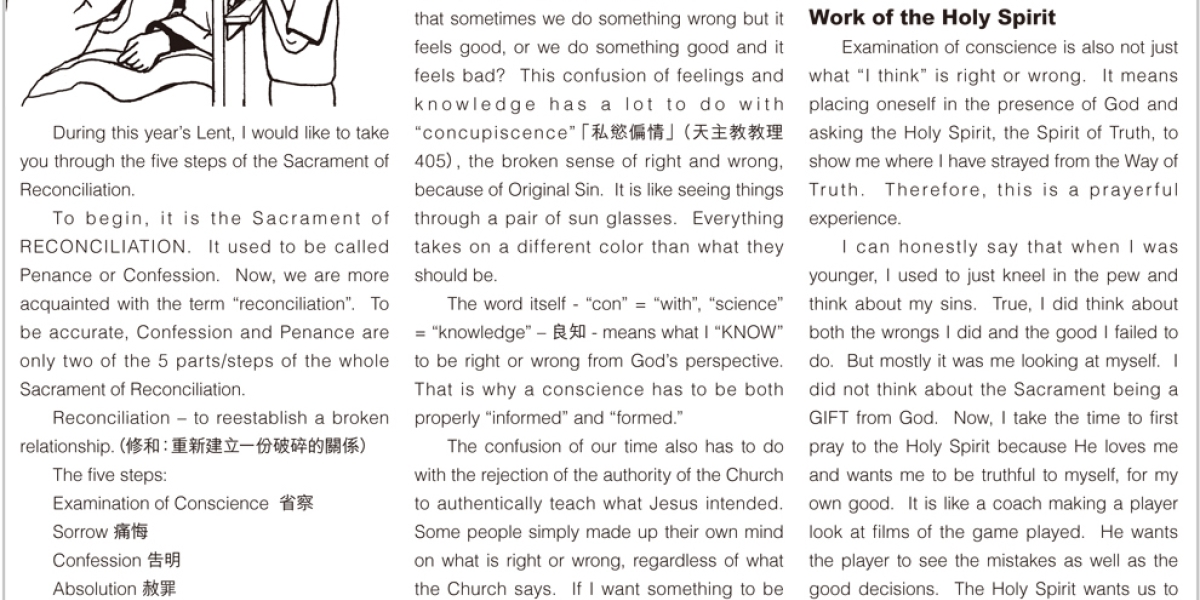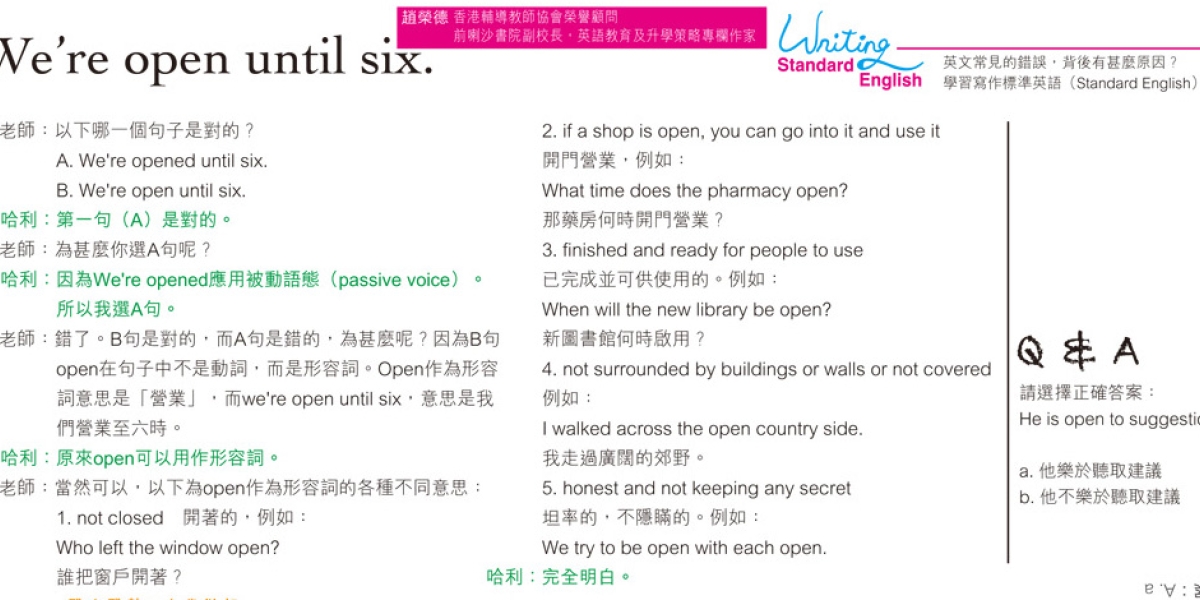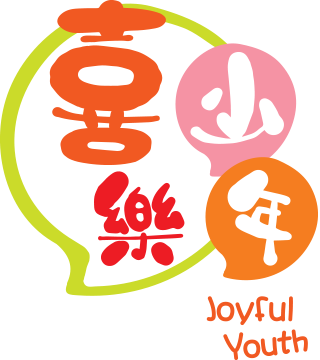昔日文章


Neither East Nor West
2012.02.26
Sacrament of Reconciliation | 修和聖事
During this year’s Lent, I would like to take you through the five steps of the Sacrament of Reconciliation.
To begin, it is the Sacrament of RECONCILIATION. It used to be called Penance or Confession. Now, we are more acquainted with the term “reconciliation”. To be accurate, Confession and Penance are only two of the 5 parts/steps of the whole Sacrament of Reconciliation.
Reconciliation – to reestablish a broken relationship.(修和:重新建立一份破碎的關係)
The five steps:
Examination of Conscience 省察
Sorrow 痛悔
Confession 告明
Absolution 赦罪
Penance 補贖
This week I will focus only on Examination of Conscience.
It is important to first look at the word conscience.
Conscience 良心(或良知)
Too often, the word conscience is used to mean how I “feel” about something. If I feel something is wrong then I have done something wrong. Is that really true? Why is it that sometimes we do something wrong but it feels good, or we do something good and it feels bad? This confusion of feelings and knowledge has a lot to do with “concupiscence”「私慾偏情」(天主教教理 405), the broken sense of right and wrong, because of Original Sin. It is like seeing things through a pair of sun glasses. Everything takes on a different color than what they should be.
The word itself - “con” = “with”, “science” = “knowledge” – 良知 - means what I “KNOW” to be right or wrong from God’s perspective. That is why a conscience has to be both properly “informed” and “formed.”
The confusion of our time also has to do with the rejection of the authority of the Church to authentically teach what Jesus intended. Some people simply made up their own mind on what is right or wrong, regardless of what the Church says. If I want something to be right, I just decide that it is right for me. They say history has shown that the Church has made many mistakes, therefore, why is the Church trying to tell me what to do?
In other words, we have decided that we are the only ones responsible for what is TRUTH! Sadly, many people think this way, and that is why so many no longer go to Confession.
Work of the Holy Spirit
Examination of conscience is also not just what “I think” is right or wrong. It means placing oneself in the presence of God and asking the Holy Spirit, the Spirit of Truth, to show me where I have strayed from the Way of Truth. Therefore, this is a prayerful experience.
I can honestly say that when I was younger, I used to just kneel in the pew and think about my sins. True, I did think about both the wrongs I did and the good I failed to do. But mostly it was me looking at myself. I did not think about the Sacrament being a GIFT from God. Now, I take the time to first pray to the Holy Spirit because He loves me and wants me to be truthful to myself, for my own good. It is like a coach making a player look at films of the game played. He wants the player to see the mistakes as well as the good decisions. The Holy Spirit wants us to see the mistakes we need to correct, guide us in making better decisions so we continue to grow, all for our own enjoyment of life.
Have a blessed Lent!


語文 8 達通
2012.02.19
「二」還是「兩」?
小寰對哥哥說︰「哥哥,你看,中文真麻煩!『2』這個數目字,在使用時,有時要說『二』,有時要說『兩』,真要命!」 小德說︰「你不用愁,用『二』還是用『兩』也有規則可尋的。」 「真的嗎?好極了!請你教教我吧!」小寰說。 小德不慌不忙,立即在一張紙上列出一個表格︰ 使用規則 『二』還是『兩』 讀寫數目,如︰一、二、三; 讀寫小數和分數,如︰一點二、三分之二; 讀寫多位數中的百位、十位、個位,如︰二百二十二、一百二十四; 表示次序(序數):第二、二樓、二叔。 用「二」 在一般量詞前面,如︰兩個人、兩斤、兩位、兩天; 表示不定的數目,如︰他真有兩下子、一兩天、說一兩句話; 表示雙方,如︰兩全其美、兩廂情願、一舉兩得。 用「兩」
小寰說︰「你的表格很清楚,但有沒有例外情況呢?」 小德再在紙上列出另一表格,說︰「這是一些常見的例外情況。」 在『千』前面、『萬』和『億』後面,如︰二千三百、兩億二千萬、六萬二千 傳統的度量衡單位前可以說或寫︰二斤/兩斤、二畝/兩畝,但是,「二兩」卻不可寫成「兩兩」。 多用「二」 用「兩」 多位數中,百位、十位、個位用「二」不用「兩」,如:二百二十二; 「千、萬、億」前面,可用「二」或「兩」,如︰兩千/二千、兩萬/二萬、兩億/二億; 但是,像「五萬二千」、「兩億二千萬」,由於「千」在「萬」或「億」的後面,多數用「二」。 少用「二」 多用「兩」
小寰說︰「哥哥,我明白了,謝謝!」


Writing Standard English
2011.10.28
We're open until six
趙老師:以下哪一個句子是對的?
A. We're opened until six.
B. We're open until six.
哈利:第一句(A)是對的。
趙老師:為甚麼你選A句呢?
哈利:因為We're opened應用被動語態(passive voice)。所以我選A句。
趙老師:錯了。B句是對的,而A句是錯的,為甚麼呢?因為B句open在句子中不是動詞,而是形容詞。Open作為形容詞意思是「營業」,而we're open until six,意思是我們營業至六時。
哈利:原來open可以用作形容詞。
趙老師:當然可以,以下為open作為形容詞的各種不同意思:
1. not closed 開著的,例如:
Who left the window open?
誰把窗戶開著?
2. if a shop is open, you can go into it and use it
開門營業,例如:
What time does the pharmacy open?
那藥房何時開門營業?
3. finished and ready for people to use
已完成並可供使用的。例如:
When will the new library be open?
新圖書館何時啟用?
4. not surrounded by buildings or walls or not covered
例如:
I walked across the open country side.
我走過廣闊的郊野。
5. honest and not keeping any secret
坦率的,不隱瞞的。例如:
We try to be open with each open.
哈利:完全明白。


Neither East Nor West
2011.09.16
A New Stat
Hello again,
I have been asked to write this column with a new heading. I have chosen “Neither East Nor West” to more appropriately show where I am, personally. I finished Lower 6 at St. Joseph’s College, Hong Kong and went to the US for university in 1970. So I am definitely East. I have been here since. 40 years! So, definitely West. Very confused.
Since I last wrote I have been back from Taiwan and am now in a parish in the United States in the state called Nebraska. Not many people have heard of it. It is actually in the middle of the United States, approximately 500 miles west of Chicago, same distance north of Dallas and east of Denver. It is hot (35) in the summer and cold (-30) in the winter.
The parish I am now assigned has a mixture of city and rural people. Plattsmouth, the town I am in, has a population of 7,000 and is about 20 miles from the city of Omaha which has a population of about 500,000. Many people live here and work at Omaha. It also has farmers that grow corn, soy bean and sorghum. The town is right on the bank of the Missouri. It has beautiful bluffs and trees. The parish has a Catholic grade school with children from kindergarten to 8th grade. The students from grades 9 to 12 attend a Catholic high school in the next parish. I came back from being a student to become a superintendent (head master or whatever you now call it in HK) again. I will miss not having any responsibilities except to study.
A couple of weeks ago, over the first weekend of September, I went to visit my family in Canada. I also attended a retreat with 200 Chinese Catholic young people. Yes, 200. They came from all over Eastern Canada. I try to join them every chance I have. They sang, played skits, listened to talks and participated in the Sacraments with gusto. I get excited about our faith just being with them. If you want to look them up, you can find them at ECCCLC.NET. On their web page you will also find links to two other retreats, WCCCLC in Vancouver and CACCLC in California, a total of about 500 Chinese Catholics gathering together in one weekend growing in love with Jesus.
With so many conflicting voices these days it is difficult enough to try to be good. It is even harder to try to be Christian, Catholic Christian. It takes a healthy dose of skepticism to ask questions about issues that are popularly accepted and a courageous faith to trust in Jesus showing us the way through the teachings of the Catholic Church. It is important to keep in mind that we are created by God who is good and true. That means that within each of us there is an insatiable need to find what is the ultimate good and true and that God is more interested in us achieving that goal than we are. It is like being in the classroom. Teachers love to give good grades. Teachers love to see students excited about learning their lessons to get the good grades. Jesus is our good Teacher. He wants us to know and to love what is His Truth.
In the upcoming columns I will try to share my faith with you however I may be moved by the Holy Spirit. Please feel free to contact me through this column and make suggestions to what you would like to read about.
Have a good school year.


